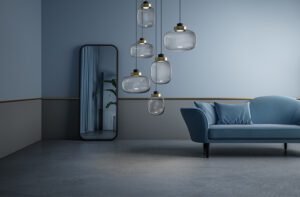Simple Pleasures
June 13, 2011
Text by Paula M. Bodah Photography by Michael Partenio
Who better to lovingly restore a Colonial-era Nantucket home than a couple who have summered on the island for nearly two decades? And not just any couple: besides being husband and wife, Eric Rosenberg and Michele Kolb are architects who have worked together for twenty-five years on residential and commercial projects internationally and in the United States.
At around 1,700 square feet, their Nantucket home hardly ranks among the pair’s biggest undertakings, but it’s probably safe to say it’s high on their list of favorites. The house, built in 1747, had been modernized over the years, of course, but still retained its essence as a classic Nantucket-style dwelling—“basically a saltbox,” Kolb says.
Before they could bring it fully into the twenty-first century and make it the kind of summer sanctuary they envisioned for themselves and their four sons, the couple needed to stabilize the ancient structure. “We did that from above,” Kolb explains. “We lifted the house and built a new foundation.”
They removed old wood, dug out the crawl space, installed new supporting beams and added a concrete slab. “We wanted to capture the crawl space as part of the envelope of the house, to eliminate moisture and control the climate,” Kolb explains.
The house now has a LEED certificate pending, Kolb says, and she anticipates it will earn Nantucket’s first gold rating for a historic home. “We felt a strong commitment to this,” the architect says. “It has a slight extra cost, but it makes a big difference in efficiency and quality and in environmental responsibility.”
On the first level, the couple reworked the floor plan, opening up a maze of small rooms to create a spacious living area. The old living room and a downstairs bedroom became the new family room, which flows into the dining room and the kitchen. A smaller living room lends itself to a bit of adult privacy.
As they dismantled walls and floors, Kolb and Rosenberg reused as much material as they could. The process fascinated the couple. “As we opened more and more of the house, the old timber structure revealed itself,” Kolb recalls. “Each layer we took off would give us another piece of the puzzle of the history of the house.”
When they took down the newer walls of the stairway to the second floor, for example, they discovered the original timbers, which had acquired a beautiful patina over their two-and-a-half centuries of existence. “It gave us clear instructions,” Kolb says with a laugh. “ ‘Don’t touch it; just dust it off. It has its own unique quality that you can’t duplicate.’ ”
In rebuilding the walls, the architects used American Clay, a natural clay product from New Mexico that’s applied with a trowel. “It gives the quality of what the original plaster walls might have felt like,” Kolb says. What’s more, she notes, the material is reputed to remove negative ions from the air. “It sounds quirky, but it really does have a calming effect.”
Throughout the house, in finishes and decoration, the couple sought out materials that respected the home’s location. “We wanted to reflect the tone and feel of the climate,” Kolb says.
On Nantucket, that means creating a low-maintenance ambience that’s light and airy, with all the ease one expects of island living. For the kitchen cabinets, Kolb worked with the carpenter to give the oak the look and feel of driftwood. For the floors, she used distressed reclaimed oak. “It was the one thing that was the biggest cost,” she confesses, “but between the plaster walls and the antiqued floor, it just makes the space.”
Furniture, rugs and fabrics were all chosen for comfort and easy care, and most came from Kolb and Rosenberg’s own home furnishings business, Belongings. The boutiques, on Nantucket and the Turks and Caicos islands, reflect the couple’s sensibility. “Our style is very eclectic,” Kolb says. “We lean toward an ease of living, a refined beach luxury.”
Sofas, chairs and chaises wear Belgian linens treated for durability. Wooden coffee and end tables have a charming distressed quality, as though they’d been weathering the island’s salt air for generations. Objects Kolb has discovered—driftwood lamps, a vintage iron wheel—become one-of-a-kind accessories. Her color scheme, too, with its emphasis on sand, blue and white, reflects the sea, sand and sky of the island. The whole effect is casual and comfortable, but with an unmistakable note of sophisticated elegance.
The second floor holds the family’s sleeping quarters, including two bedrooms and a bath for the boys, plus a generous master bedroom and bath. “We didn’t do much major partitioning on the second floor,” Kolb says, “other than to convert what was a laundry room into a second bathroom.”
The changes they did make—revealing ceiling timbers and, in the master bedroom, breaking through the ceiling to capture the attic space for additional light and height—bring to this upper floor the same contented ease as the living spaces below.
The design of the original house, Kolb says, was influenced by the eighteenth-century Quaker culture on Nantucket. “Material objects were to serve a function, not create an effect. The emphasis was on restraint, balance and simple order,” she says. “These are the concepts I tried to extend to the interior finishes and furnishings.”
If the original homeowners could see their house now, they’d surely agree that the old place is as straightforward, simple and welcoming as it was always intended to be.
Architecture and Interior Design: Michele Kolb and Eric Rosenberg, Rosenberg Kolb Architects
Builder: Lindsey Knapp, Knapp Construction
Share
![NEH-Logo_Black[1] NEH-Logo_Black[1]](https://b2915716.smushcdn.com/2915716/wp-content/uploads/2022/08/NEH-Logo_Black1-300x162.jpg?lossy=1&strip=1&webp=1)



















You must be logged in to post a comment.